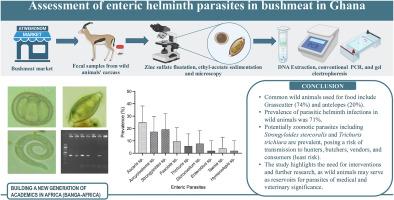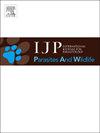评估加纳丛林肉类中的肠道蠕虫寄生虫
IF 2
3区 医学
Q3 ECOLOGY
International Journal for Parasitology-Parasites and Wildlife
Pub Date : 2024-10-17
DOI:10.1016/j.ijppaw.2024.101005
引用次数: 0
摘要
人类活动,如捕猎野生动物为食,增加了寄生虫感染阶段人畜共患传染给人类的风险。野生动物肉(俗称 "丛林肉")的处理、加工和消费,以及野生动物栖息地的暴露,都可能通过寄生虫感染阶段的传播对人类健康构成重大风险。这项研究旨在评估加工成食品的新鲜野生动物尸体中的肠道蠕虫寄生虫负担和潜在的人畜共患蠕虫。在库马西的 Atwemonom 野味市场,从总共五十(50)具野生动物尸体的直肠和肠道内容物样本中收集了八(8)个不同种类的寄生虫,对这些样本进行的寄生虫学分析表明,其中有九(9)属肠道蠕虫寄生虫,总体流行率为 71.0%。对单个寄生虫种类的流行率进行了评估,蛔虫属(Ascaris sp.)的流行率为 25%,分子评估的流行率为 87.5%。分子分析表明,所有分析样本中的寄生虫种类流行率都较高。物种特异性分析表明,野生动物中存在两种潜在的人畜共患寄生虫--Strongyloides stercoralis和Trichuris trichiura,这表明有必要加强对野生动物寄生虫感染的卫生防疫。这项研究的数据表明,野生动物除了是自然宿主外,还可能是许多具有医疗和兽医重要性的寄生虫的贮藏地。本文章由计算机程序翻译,如有差异,请以英文原文为准。

Assessment of enteric helminth parasites in bushmeat in Ghana
Anthropogenic activities, such as hunting wild animals for food, increase the risk of zoonotic transmission of infective stages of parasites to humans. The handling, processing and consumption of wild animal meat, popularly known as ‘bushmeat’, as well as exposure to wildlife habitats, can pose a significant risk to human health through the transfer of parasitic infective stages. This study sought to assess the enteric helminth parasite burden and potentially zoonotic helminths in fresh, wild animal carcasses being processed for food. Parasitological analysis of samples of rectal and intestinal contents collected from a total of fifty (50) wild animal carcasses belonging to eight (8) different species at the Atwemonom Bushmeat Market in Kumasi showed nine (9) genera of enteric helminth parasites with an overall prevalence of 71.0%. Individual parasite species prevalence was assessed, with Ascaris sp. showing 25% and 87.5% by coprological and molecular assessment, respectively. Molecular analysis showed a higher parasite species prevalence in all samples analyzed. Species-specific analysis indicated the presence of two potentially zoonotic parasites, Strongyloides stercoralis and Trichuris trichiura, in wild animals, indicating the need to intensify one health approach in wild animal parasitic infections. Data from this study suggest that wild animals in addition to being natural hosts, may also serve as reservoirs for numerous parasites of medical and veterinary importance.
求助全文
通过发布文献求助,成功后即可免费获取论文全文。
去求助
来源期刊

International Journal for Parasitology-Parasites and Wildlife
Medicine-Infectious Diseases
CiteScore
3.80
自引率
5.60%
发文量
113
审稿时长
45 days
期刊介绍:
The International Journal for Parasitology: Parasites and Wildlife (IJP-PAW) publishes the results of original research on parasites of all wildlife, invertebrate and vertebrate. This includes free-ranging, wild populations, as well as captive wildlife, semi-domesticated species (e.g. reindeer) and farmed populations of recently domesticated or wild-captured species (e.g. cultured fishes). Articles on all aspects of wildlife parasitology are welcomed including taxonomy, biodiversity and distribution, ecology and epidemiology, population biology and host-parasite relationships. The impact of parasites on the health and conservation of wildlife is seen as an important area covered by the journal especially the potential role of environmental factors, for example climate. Also important to the journal is ''one health'' and the nature of interactions between wildlife, people and domestic animals, including disease emergence and zoonoses.
 求助内容:
求助内容: 应助结果提醒方式:
应助结果提醒方式:


